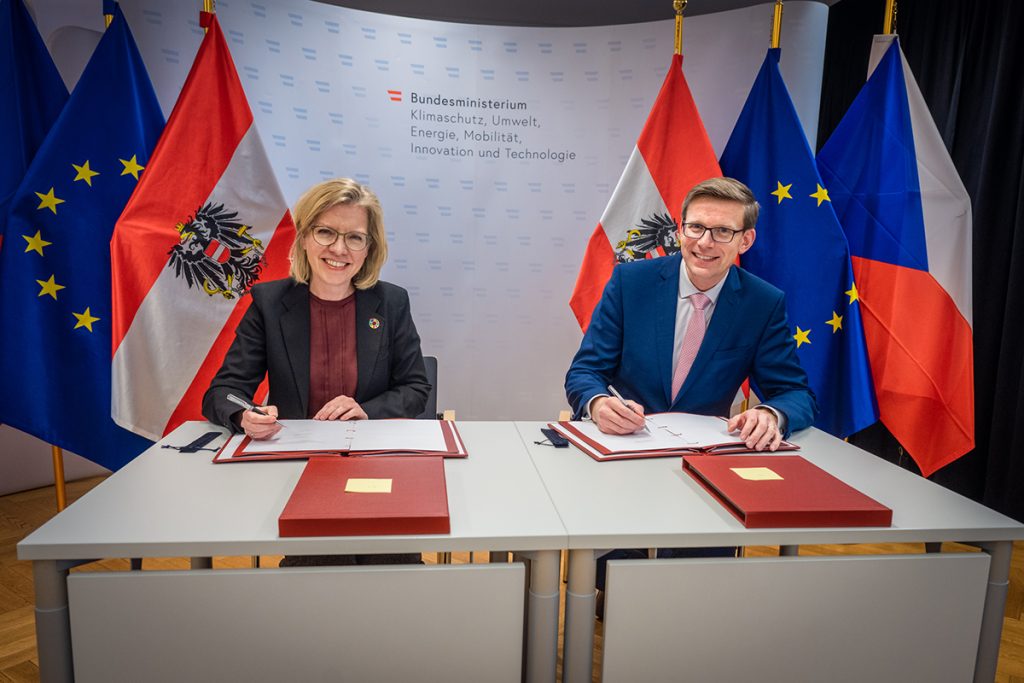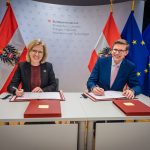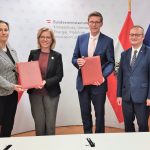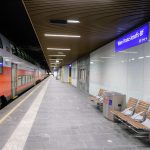 Czechia’s Minister of Transport, Martin Kupka, and Austria’s Federal Minister for Climate Action, Environment, Energy, Mobility, Innovation and Technology, Leonore Gewessler, signed a joint declaration for the modernisation and expansion of Veselí nad Lužnicí – Gmünd – Vienna cross-border railway known as the Silva Nortica railway.
Czechia’s Minister of Transport, Martin Kupka, and Austria’s Federal Minister for Climate Action, Environment, Energy, Mobility, Innovation and Technology, Leonore Gewessler, signed a joint declaration for the modernisation and expansion of Veselí nad Lužnicí – Gmünd – Vienna cross-border railway known as the Silva Nortica railway.
“We consider the development of the transport connection with Austria as one of our main priorities. Together we have signed the agreement to modernise the railway line through České Velenice [a town in Jindřichův Hradec District, South Bohemian Region],” Martin Kupka said.
The signed agreement provides for the expansion of Franz-Josefs-Bahn across borders from Vienna via Gmünd to Prague and Pilsen. Franz-Josefs-Bahn connects the capitals of Austria and the Czech Republic, and its first section entered operation in 1868.
A first milestone for this important regional transport axis was reached at the end of December 2022 when direct connections started from Franz-Josefs-Bahnhof in Vienna, via Gmünd to Prague. The two countries now intend to further increase the number of direct connections in the future, and it is expected that two more trains a day in each direction will be introduced from 2024.
“For many people in the Silva Nortica region, the Franz-Josefs-Bahn is an important connection for climate-friendly and comfortable travel. The cross-border expansion from Vienna to Prague, which we have now agreed with the Czech Republic, is more important. It is about strengthening the sustainable public transport and offering people modern infrastructure and an attractive range of services. This is how climate change succeeds,” Climate Protection Minister Leonore Gewessler said.
In medium-term, the attractiveness of rail services is to be further increased through the coordinated expansion of the railway infrastructure in Austria and the Czech Republic including the Silva Nortica railway. On both sides of the state border, for example, increases in line speeds, double-track expansion and the modernisation of safety technology are planned. In the Czech Republic there is currently also a non-electrified section of the line that is also being electrified.
In the Czech Republic, the electrification of Veselí nad Lužnicí – České Velenice railway line is being prepared which will enable an alternative connection between Prague and Vienna via Gmünd, both for passenger and freight transport. In addition, the line is also essential to the direct connection of important regional centres such as the Tulln town in Lower Austria or the Czech cities of Třeboň and Tábor, both in South Bohemian Region. The authorities intend to complete the electrification and modernisation of the line in 2028.
These measures will enable the travel time from Vienna’s Franz-Josefs-Bahnhof via the Waldviertel to Prague to be reduced by around 40 minutes from the current 5:10 hours to around 4:30 hours by 2029.
The long-term plans for the direct connection between Vienna and Pilsen cover the expansion of Budweis – Pilsen route and the Budweis node.These expansions will start in the next few years and are expected to be completed by 2032.The travel time from Vienna’s Franz-Josefs-Bahnhof to Pilsen can then be reduced by around 50 minutes to around 4:45 hours.
The agreement is part of the cross-border rail expansion between Austria and the Czech Republic. The two ministers also discussed plans for the construction of a high-speed railway Via Vindobona which will link Prague, Vienna and Berlin, as well as the creation of Prague – Linz – Salzburg connection part of Czech IV rail transit corridor towards České Budějovice. The Vienna – Brno – Prague route represents the main international axis and will be expanded into a high-speed line in the future as part of the Via Vindobona route.The connection via the Franz-Josefs-Bahn will be significantly strengthened as a regional axis in the future.The efforts of the two states will allow the Euroregion Silva Nortica to grow together even more and improve the cross-border accessibility of the Waldviertel and southern Bohemia by rail.
In 2021 an agreement was signed to expand the main axis from Vienna via Brno to Prague and on to Berlin – the so-called Via Vindobona high-speed railway. This should reduce the target travel time from Vienna to Berlin to around 4 hours and from Vienna to Prague to around 2:30 hours. In Austria, the northern rail will be modernised and expanded to allow trains to run at up to 200 km/h in the next few years.
Share on:








